
|   |

|   |
Nritya Parva 2023 - Manjari Sinha e-mail: manjari@sinha.com Photos courtesy: Parul Shah February 21, 2023 The Anjali Memorial Committee has been organizing Nritya Parva for more than forty years in Baroda. Even the depressing pandemic period could not dampen their spirit when it continued virtually online. Nritya Parva 2023, dedicated to Prof. Mary Alice (Buff) Bennan, Guru M. K. Saroja, and Pt. Birju Maharaj, was a bouquet of dance, discourse, and felicitation like always. The committee felicitated the Padma Shri awardee folk art enthusiast Joravarsinhji Jadav, who is also the Vice-Chairman of the Central Sangeet Natak Akademi, for his lifelong dedicated contribution to the presentation, preservation, and propagation of the Folk Arts of Gujarat. The annual event focused on both Shastra and Prayog, presented mesmerizing dance performances in the evenings featuring Vaibhav Arekar and his Sankhya repertory in Bharatanatyam from Mumbai, Guru Shama Bhate's Nadroop Kathak ensemble from Pune, Dr. Divya Patel with her Guru Dr. Parul Shah in Bharatanatyam abhinaya and Vishal Krishna, the brilliant Kathak exponent of Benaras Gharana from Varanasi. The 'Scholarly Musings' or 'Shastra Charcha' on books and writings was held in the morning session at Raja Ravi Varma Studio, Lakshmi Vilas Palace, in association with the IGNCA Regional Centre, Vadodara, where deliberation on dance scholarship was scheduled with Dr. Sonal Mansingh, Guru Shama Bhate, Dr. Arshiya Sethi, Ashish Khokar and yours truly. Since Sonalji could not make it, Dr. Parul Shah read excerpts from her book, preceding the panel discussions attended by the enthusiastic rasikas of Vadodara and students alike. The Anjali Memorial Committee (AMC), was established in 1981 in memory of Dr. Anjali Mehr (1928-1979), the reputed Bharatanatyam dancer, choreographer, and educator who was one of the earliest students of the legendary Rukmini Devi Arundale at Kalakshetra and later became the Head, Dept of Dance at Maharaja Sayajirao University (MSU), Baroda. The AMC has been working with a missionary zeal for more than four decades. It has established a Gold Medal in the name of Anjali Mehr, awarded to the best student in the Dept of Dance, College of Indian Music, Dance, and Dramatics, MSU, Baroda. It organizes an annual festival of dance and music promoting promising upcoming artists. It has been organizing lecture demonstrations by reputed scholars/performers and grants awards and scholarships for advanced training in Bharatanatyam and for research projects. The annual Nritya Parva is a symbol of the 'Guru Shishya Parampara' flowing virtuously, uninterrupted from Rukmini Devi Arundale to Anjali Mehr to Dr. Parul Shah who has been following in her Guru's footsteps as Dean and Head (Dance), Faculty of Performing Arts, MSU Baroda, passing on this precious legacy to her students and offering 'Nritya Parva' as an ode to fulfill the promise to her Late Guru. It was in 1972-73 when Parul was invited for her first-ever solo performance in Delhi. Her esteemed Guru who conducted the live orchestra believed that Arangetram means blessings. So she took Parul to the Dakshinamurthy Shiva temple for the Arangetram rituals with the Pooja of ankle bells and all, herself accepting just one and a quarter rupees (a one rupee coin and a 25 paise coin) as Guru Dakshina but with a promise that whatever Parul would earn through dance, she would always put back at least its twenty percent for the dance itself. Parul Shah has kept that promise along with offering tribute to her Guru on her death anniversary every year with 'Nritya Parva', a three-day festival of dance featuring the best of dance performers and scholars, bringing Shastra and Prayog together. The post-pandemic in-person Nritya Parva held at MSU's CC Mehta Auditorium, fragrant with the beautiful floral Alpana in the foyer was not only filled with dance lovers but also graced by Rajmata Shivangini Devi Raje Gaekwad, the Chancellor of MSU, who was also present in the morning session of 'Shastra Charcha' at the Raja Ravi Varma Studio. The lighting of the auspicious lamp on the inaugural evening was followed by the felicitation of the Gujarati folk art scholar Joravarsinhji in the most befitting manner when a group of Garba dancers led by Parul Shah, dancing their way up to the stage surrounded him sitting with dignitaries on the dais, while the audience clapped to the rhythm of the ceremonial Garba. The AMC invited all the cultural institutes of Vadodara to join hands in felicitating the dedicated artiste scholar of the Gujarati folk arts. Moved with this kind of adoration Joravarsinhji poured his heart out in his Gujarati speech. 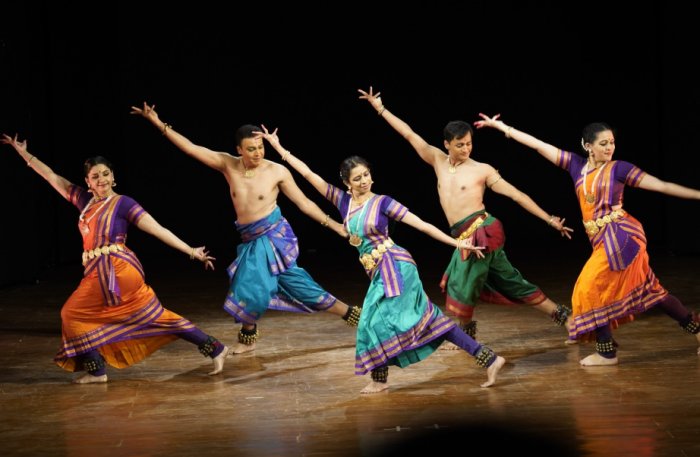 Abhanga Ranga The dance presentation opened with 'Abhanga Ranga', a musical garland of Abhangas, the devotion soaked poems written by the saint poets of Maharashtra, interpreted through the vibrant vocabulary of Bharatanatyam by Vaibhav and the chiseled dancers of his Sankhya Dance Company. The first Abhanga by Sant Tukaram "Rupacha Abhanga" or the 'Roop Kirtana', invoking the divine form of Vitthala, celebrated the Sagun Bhakti. A beautiful group choreography based on Alarippu where the brilliance of the dance went in double the speed of the Abhanga being sung as an invocation to Panduranga, describing the grandeur of his Sagun Roop. The dancers gradually exit and Vaibhav stands center stage as the Dhanurdhari Rama for the second Abhanga "Dhanya te Sansari...". His reflection looms large at the backdrop with imaginative light designing, underlining the Mahima or greatness of Rama Nama. This Namdeva Abhanga narrates the story of Rama through three episodes from Ramayana, Tadka Vadha, Ahilya Uddhar, and Seeta-Swayamvara presented by Vaibhav with four other dancers. Conceived and choreographed in the Varnam format with crisp jathis depicting these episodes most convincingly in the shortest vignettes possible, Vaibhav was able to create the desired effect of Kaivalya Nama, establishing the fact that Rama Nama is the lakshya, the ultimate destination. The third Abhang "Eka arohana" by Sant Eknath talks of Ekeshwara vaad where the boundaries of caste, creed, colour, and the divides like Shaiva or Vaishnava merge into one despite the apparent contrast in Shiva's vahan Nandi and Vishnu's Garuda, "Ekarohana Nandi, eka Garuda vaahane...". The stanzas of the song go on comparing the Bhasma vs Chandana, Jata joot vs ratna kireet..., finally the poet merges them as one in Hari-Hara, with no distinction between the two. The last Abhanga by Sant Tukaram described the Vari, the pilgrimage of the Varikari sampradaya to Pandharpur, reaching the Abhanga Ranga to its climax, with pilgrims commuting on foot singing/dancing to the chants of Vitthala. 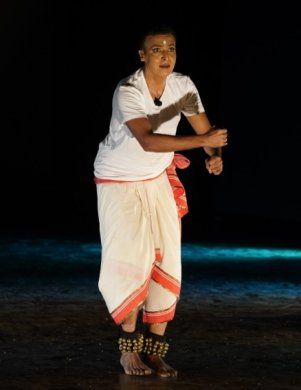 Vaibhav Arekar The second half was a solo dance-drama 'Debotar Grash' by Vaibhav based on Tagore's poem of the same name. It was the story of a mother and her child. The mother wants to go on a pilgrimage leaving the child behind with her sister, but the child is determined to go with her. Angered at his insistence the mother admonishes that she will give him to the sea if he persists, but the child comes along with her. On the way, the ship is engulfed by the storm. The passengers tell her that since she had promised her son as an offering to the sea she will have to keep her promise, otherwise no one will be spared. The mother gets pangs of guilt and horror as she remembers her words and is eventually forced by her fellow travelers to offer her son to the sea. This piece brought forth Vaibhav's immersive approach and his moving abhinaya with intensity. Though the language Bengali was a hurdle for the Gujarati rasikas, the imaginatively conceived and composed music could easily reach them. This was evident from the very beginning where the opening aalap in the serene swaras of raga Bhathiyar and the throb of the child's heart in the mother's womb, connected them instantly to the vatsalya rasa from the child's birth till the concluding scene where the miserable mother offers her adored son to the sea echoing in the pathos of raga Marwa augmenting Vaibhav's subtle abhinaya that leaves the audience teary eyed! 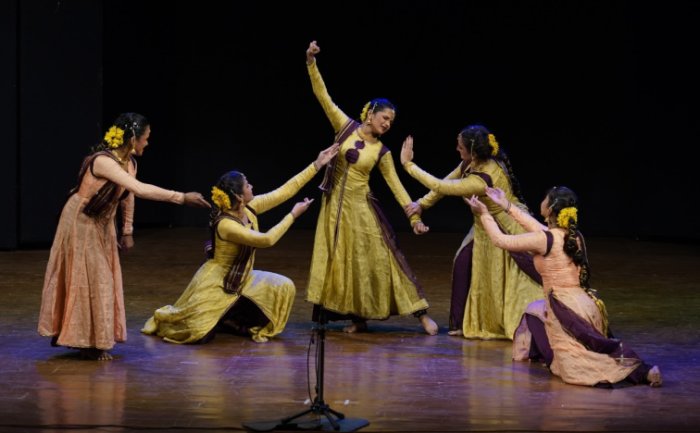 Shama Bhate's group The Kathak Nritya Parampara of Guru Shama Bhate had its own signature in 'Umang', the next evening. Fifty years of dance experience as a performer, teacher, choreographer, artistic director, thinker, and the founder of Naadroop, showcased Guru Shama Bhate and her dance works in full abundance by the group of her well-trained students. Opening with Shiva Vandana with the meditative aalap and Dhrupad in Adana set to Sool Tala by the Gundecha Bandhu set her classy standard from the very beginning. Vasant Ritu celebrated the vibrant nature's bounty through the perfection of Rekha (lines), Aakar (form), and Aakash (space) set to a traditional Tarana of Gwalior Gharana on one hand and the rhythmic intricacies on the other, playing hide and seek with the tala on pakhawaj and tabla and the crispness of the corresponding footwork with the Ateet and Anagat ka Kaam where the 'sam' is shown either ahead of the expected matra or it gives a feel of belated coming on 'sam'. The playfulness of the rhythm was also marked by the varying points of stress on different matras, where the dancers reveled in rhythm. This was followed with a Hori composition "Rang darungi Nand ke laalan par...." with the exuberance of the festival of colours where the Gopis catch hold of Krishna and transform him into a maiden decorating him with lahenga, chunri, bindi, jhumka and putting colours on his cheeks. The fascinating group choreography reached its climax with the Bhairavi Chaturang "Aaj Radha Brij ko chali" concluding with the Dashavatara shloka of Jayadeva's Geeta Govinda. The aesthetically choreographed Gat-nikas, Gat-bhava, and the intricacies of the crisp Tatkaar (footwork) with the stress of different matras, were the added attraction. Guru Shama Bhate presented each and every item with the perfect flair of anchoring. 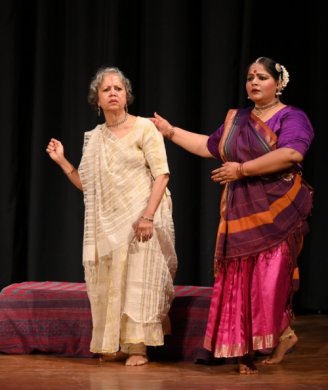 Parul Shah and Divya Patel The third and concluding evening opened with Bharatanatyam by Dr. Divya Patel who performed for the first time Ashtanayika in Gujarati, written by Anjali Mehr. The live orchestra with vocals by Janaki Mithaiwala and Romil Jani, sarangi by Iliyas Khan, tabla by Jagdeep Lakum, and mridangam by Shiva Kumar Pillai enhanced the abhinaya of each Nayika, choosing appropriate ragas like Shyama Kalyana for the Vasakasajja, only aalap on sarangi for Kalahantarita, although the synthesizer felt jarring with "Priye Charushile", where just a pair of taanpuras would have fared much better. Raga Jhinjhoti and tala Rupak were perfect for the Ashtapadi of Jayadeva and raga Megh for Virahotkanthita. Khandita on recorded music sounded a come down in contrast with the live music for other Nayikas. The last Ashtapdi "Sa virahe tava deena..." saw Parul enacting Radha, yearning for her beloved Krishna, and the Sakhi enacted by her disciple Divya Patel, explaining her predicament to Krishna, requesting him to come to the virahini Radha pining for him. Watching Parul's subtle abhinaya one wished it were performed with live music. 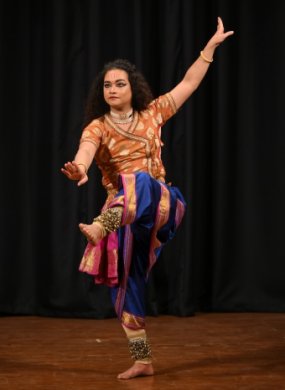 Vishal Krishna The festival concluded with a scintillating solo performance by Vishal Krishna, the brilliant representative of the Benaras Gharana of Kathak, who belongs to the famous lineage of Sitara Devi and Gopi Krishna. Accompanied on tabla by Uday Shankar Mishra, sarangi by Iliyas Khan, and vocal support by Kaushik, Vishal opened with Shiva-Stuti "Om Namah Shivaay" thoughtfully composed in raga Shankara with the Kavitta "Dimik dimik dim damru baaje...", preceding the Dhrupad "Shankar Mahadeva" in Shankara itself. The Tabla Uthaan in typical Kishan Maharaj style where Uday began with just the right hand, then only with the left hand and finally joined both coming emphatically on 'sam' with an impressive Tihai got him spontaneous applause, but surprisingly with the Dhrupad he played Drut Ektala instead of Chautala which is conventionally played with a Dhrupad composition. This liberty may have been taken because both the talas consist of twelve beats cycle! Vishal shifted to Vilambit Teentaal and performed the Chalan, Thaat, Uthaan, Aamad and Paran-Jodi Aamad "Dhatak Thunga..." in two ways and a Sawal-Jawab jugalbandi of bols, the Kathak mnemonics before proceeding to Madhya Laya, the medium tempo. He presented the choicest gems of his repertoire including Birju Maharaj's Tihais and Sitara Devi's 'machine gun' style "kit tak thun thun..." et al. For the Bhava-Abhinaya segment, he chose the devotional Pada "Aaj Gopal liye Brij bal..." choreographed by Madhavi Mudgal. It was about Radha's desire to see Krishna as a peacock when she couldn't find a real one in the Kunjavana and Krishna obliges. Vishal performed a beautiful Mayur Gat along with other lyrical Gat-Nikas and concluded with Tatkar, the intricate footwork standing on the edge of a copper plate, which he said was a specialty of his Gharana popularised by Alaknanda Devi. The complicated rhythmic variations in Tisra, Chatusra, and Misra Jati got him repeated applause. 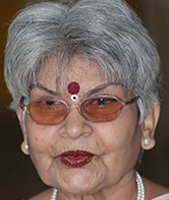 Manjari Sinha has an M.A. in Sanskrit and Music, and trained in vocal, tabla, sitar and Kathak dance. She has regular columns in national dailies as a music and dance critic. |